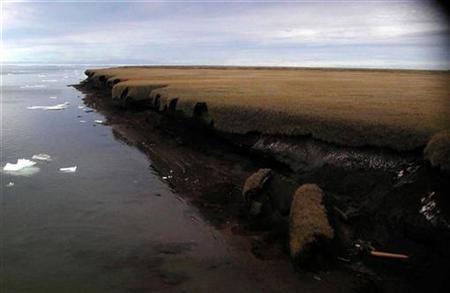Date: 01-Jul-09
Country: SINGAPORE
Author: David Fogarty
Permafrost Melting a Growing Climate Threat Photo: David Fogarty

A handout photo from 2004 shows coastal erosion of mud-rich
permafrost along on Beaufort Sea coastline Drew Point in Alaska.
Photo: David Fogarty
SINGAPORE - The amount of carbon locked away in frozen soils in the far
Northern Hemisphere is double previous estimates and rapid melting could
accelerate global warming, a study released on Wednesday says.
Large areas of northern Russia, Canada, Nordic countries and the U.S. state
of Alaska have deep layers of frozen soil near the surface called
permafrost.
Global warming has already triggered rapid melting of the permafrost in some
areas, releasing powerful greenhouse gases carbon dioxide and methane.
As the world gets warmer, more of these gases are predicted to be released
and could trigger a tipping point in which huge amounts of the gases flood
the atmosphere, rapidly driving up temperatures, scientists say.
"Massive amounts of carbon stored in frozen soils at high latitudes are
increasingly vulnerable to exposure to the atmosphere," said Pep Canadell,
executive director of the Global Carbon Project at Australia's state-funded
Commonwealth Scientific and Industrial Research Organization.
"The research shows that the amount of carbon stored in soils surrounding
the North Pole has been hugely underestimated."
The study is published in the latest issue of Global Biogeochemical Cycle.
Canadell said a four-year study of the latest research on permafrost, data
from new drilling projects as well as the release of previously unpublished
data from the Russian Academy of Sciences had led to a rethink of carbon
levels.
"Projections show that almost all near-surface permafrost will disappear by
the end of this century exposing large carbon stores to decomposition and
release of greenhouse gases," he said in a statement.
He said if only 10 per cent of the permafrost melted, this could lead to the
release of an additional 80 parts per million of carbon dioxide equivalent
into the atmosphere. This would equate to about 0.7 degrees Celsius of
global warming.
According to the U.N. Climate Panel, average temperatures have already risen
by about 0.7 deg C since the late nineteenth century and are forecast to
rise another 1.8 to 4 deg C by 2100, Scientists say a rapidly warming planet
will trigger more intense storms and droughts, rising seas and melting ice
caps.
Canadell said that on a recent trip to northern China, the permafrost at its
southern limit had all but disappeared over the past 20 years.
Locals had told him the permafrost was once 20 cm below the surface and now
it was several meters down, he told Reuters from Canberra, Australia.
In the statement, he said computer models showed global warming could
trigger an irreversible process of thawing.
For example, heat generated from increased microbial activity in the soil
could lead to sustained and long-term emissions of carbon dioxide and
methane.
In addition, lakes formed as permafrost thaws would draw heat to deeper
layers and bring methane trapped in pockets below to the surface.
© Thomson Reuters 2009 All rights reserved
